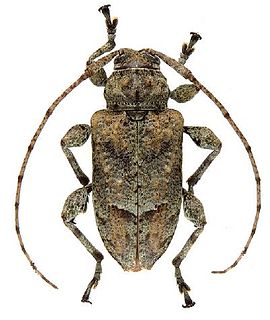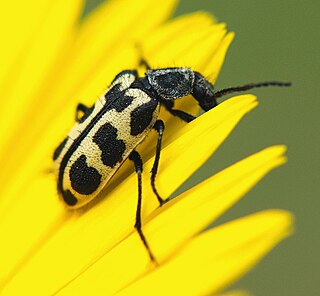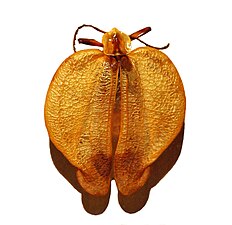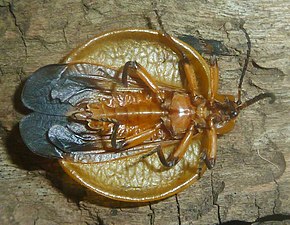
Oedemera is a genus of beetles of the family Oedemeridae, subfamily Oedemerinae.

Trox scaber is a beetle of the family Trogidae. The 5 to 8 mm long insect is found worldwide, including in Europe, and lives in bird nests.

Leptostylopsis annulipes is a species of longhorn beetles of the subfamily Lamiinae.

Cebrionini is a tribe of click beetles from the family Elateridae; formerly ranked as a subfamily or family, they are now considered a tribe within the subfamily Elaterinae.

Anthia thoracica, the two-spotted ground beetle, is a species of beetles of the family Carabidae.

Astylus atromaculatus is a species of beetle in the family Melyridae. It is variously known as the spotted maize beetle, or pollen beetle. It is indigenous to Argentina and neighbouring countries, but has been accidentally imported into various other regions such as the warmer regions of North America and much of Africa, where it has become invasive.
Bucolus fourneti is a native Australian, small, hairy coccinellid beetle approximately 2.1-4.5 mm in diameter. It was described by Étienne Mulsant in 1850
Margarinotus ephemeralis is a species of clown beetle in the family Histeridae. It is currently only known from southern California.

Chilocorus nigritus, sometimes referred to as the Malaysian ladybird beetle, is a species of lady beetle in the family Coccinellidae. It is native to SE Asia, but has been introduced for use in biological pest control in Hawaii and any parts of the world, including Europe.

Henosepilachna argus, common name bryony ladybird, is a species of beetle in the family Coccinellidae.

Neocalaphodius moestus, is a species of dung beetle found throughout the countries in Afrotropical, Palaearctic and Indian subcontinent.
Onthophagus favrei, is a species of dung beetle found in India, and Sri Lanka.
Mylabris thunbergi is a species of blister beetle found in India, and Sri Lanka.
Abscondita chinensis, is a species of firefly beetle found in India, China and Sri Lanka.
Neptosternus starmuehlneri, is a species of predaceous diving beetle found in Sri Lanka.
Neptosternus taprobanicus, is a species of predaceous diving beetle found in Sri Lanka.

Hydaticus pacificus, is a species of predaceous diving beetle found in South and South East Asia.
Chilocorus subindicus, is a species of lady beetle found in India, Sri Lanka and Maldives.
Megalocaria dilatata, is a species of lady beetle native to India, Sri Lanka and Bhutan.
Phoberus ngomensis is a species of hide beetle in the subfamily Troginae discovered by the scientists van de Merwe and Scholtz in 2005. Like with many other beetle species, P. ngomensis has not been observed again after its discovery, so all knowledge of the species comes from the 166 individual beetles van de Merwe and Scholtz saw during fieldwork.














